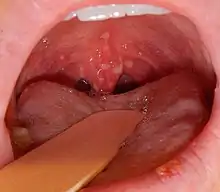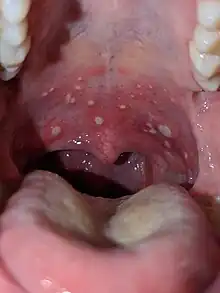| Herpangina | |
|---|---|
 | |
| An example of herpangina in a child | |
 | |
| Specialty | Infectious diseases |
Herpangina, also called mouth blisters, is a painful mouth infection caused by coxsackieviruses. Usually, herpangina is produced by one particular strain of coxsackie virus A (and the term "herpangina virus" refers to coxsackievirus A),[1] but it can also be caused by coxsackievirus B or echoviruses.[2] Most cases of herpangina occur in the summer,[3] affecting mostly children. However, it occasionally occurs in adolescents and adults. It was first characterized in 1920.[4]
Signs and symptoms
Symptoms include sudden fever with sore throat, headache, loss of appetite, and often neck pain. Within two days of onset, an average of four or five (but sometimes up to twenty) 1 to 2 mm diameter grayish lumps form and develop into vesicles surrounded by redness. Over the next 24 hours, these become shallow ulcers, rarely larger than 5 mm diameter that heal in one to seven days. These lesions most often appear on the tonsillar pillars (adjacent to the tonsils), but also on the soft palate, tonsils, uvula, or tongue.[5]
A small number of lesions (usually two to six) form in the back area of the mouth, particularly the soft palate or tonsillar pillars. The lesions progress initially from red macules to vesicles and lastly to ulcerations, which can be 2–4 mm in size.[6]
Cause
Typically spreads via the fecal-oral route or via respiratory droplets.[6]
Diagnosis
A diagnosis can be made from clinical signs and symptoms, and treatment consists of minimizing the discomfort of symptoms.[5] It can be differentiated from herpetic gingivostomatitis by the positioning of vesicles - in herpangina, they are typically found on the posterior oropharynx, as compared to gingivostomatitis where they are typically found on the anterior oropharynx and the mouth.[7]
Treatment
Treatment is usually supportive only,[8] as the disease is self-limiting and usually runs its course in less than a week.
Epidemiology
- Most commonly affects infants and young children
- Typically occurs during the summer
Etymology
The term is derived from Greek herp 'creeping, snakelike' and Latin angina 'quinsy', literally "inflammation or swelling of the throat or part of the throat, esp. tonsillitis".[9][10]
References
- ↑ "Herpangina Virus""at Dorland's Medical Dictionary
- ↑ "Herpangina""at Dorland's Medical Dictionary
- ↑ Michael I. Greenberg (2005). Greenberg's text-atlas of emergency medicine. Lippincott Williams & Wilkins. p. 156. ISBN 978-0-7817-4586-4. Retrieved 11 April 2010.
- ↑ Ralph D. Feigin (2004). Textbook of pediatric infectious diseases. Elsevier Health Sciences. p. 170. ISBN 978-0-7216-9329-3. Retrieved 11 April 2010.
- 1 2 "Herpangina". Merckmanuals.com. Merck. Retrieved 21 December 2014.
- 1 2 Yu H, Li XW, Liu QB, Deng HL, Liu G, Jiang RM, Deng JK, Ye YZ, Hao JH, Chen YH, Nong GM, Shen ZB, Liu CS, Zou YX, Wu JZ, Wu XD, Chen BQ, Luo RP, Lin AW, Chen Y, Liu XD (April 2020). "Diagnosis and treatment of herpangina: Chinese expert consensus". World J Pediatr. 16 (2): 129–134. doi:10.1007/s12519-019-00277-9. PMID 31347021.
- ↑ Parrot, RH; Wolf, SI; Nudelman, J; Naiden, E; Huebner, RJ; Rice, EC; McCullough, NB (August 1954). "Clinical and laboratory differentiation between herpangina and infectious (herpetic) gingivostomatitis". Pediatrics. 14 (2): 122–9. PMID 13185685.
- ↑ "ULCERATIVE LESIONS OF THE ORAL CAVITY". Utmb.edu. Archived from the original on 7 September 2013. Retrieved 21 December 2014.
- ↑ "Oxford English Dictionary". Oed.com. Retrieved 21 December 2014.
- ↑ "Quinsy - Define Quinsy at Dictionary.com". Dictionary.com. Retrieved 21 December 2014.